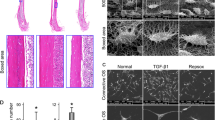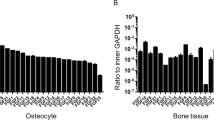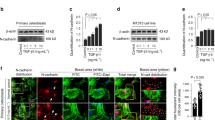Abstract
Insulin-like growth factor I (IGF-I) is expressed in many tissues, including bone, and acts on the proliferation and differentiation of osteoblasts as an autocrine/paracrine regulator. Tight-junction proteins have been detected in osteoblasts, and direct cell-to-cell interactions may modulate osteoblast function with respect, for example, to gap junctions. In order to investigate the regulation of expression of tight-junction molecules and of function during bone differentiation, osteoblast-like MC3T3-E1 cells and osteocyte-like MLO-Y4 cells were treated with IGF-I. In both MC3T3-E1 cells and MLO-Y4 cells, the tight-junction molecules occludin, claudin-1, -2, and -6, and the gap-junction molecule connexin 43 (Cx43) were detected by reverse transcription with polymerase chain reaction. In MC3T3-E1 cells but not MLO-Y4 cells, mRNAs of claudin-1, -2, and -6, Cx43, and type I collagen, and proteins of claudin-1 and Cx43 were increased after treatment with IGF-I. Such treatment significantly decreased paracellular permeability in MC3T3-E1 cells. The expression of claudin-1 in MC3T3-E1 cells after IGF-I treatment was mainly upregulated via a mitogen-activated protein (MAP)-kinase pathway and, in part, modulated by a PI3-kinase pathway, whereas Cx43 expression and the mediated gap-junctional intercellular communication protein did not contribute to the upregulation. Furthermore, in MC3T3-E1 cells during wound healing, upregulation of claudin-1 was observed together with an increase of IGF-I and type I collagen. These findings suggest that the induction of tight-junction protein claudin-1 and paracellular permeability during the differentiation of osteoblast-like MC3T3-E1 cells after treatment with IGF-I is regulated via a MAP-kinase pathway, but not with respect to gap junctions.






Similar content being viewed by others
References
Arana-Chavez VE, Soares AM, Katchburian E (1995) Junctions between early developing osteoblasts of rat calvaria as revealed by freeze-fracture and ultrathin section electron microscopy. Arch Histol Cytol 58:285–292
Balda MS, Matter K (2003) Epithelial cell adhesion and the regulation of gene expression. Trends Cell Biol 13:310
Bennett MVL, Barrio LC, Bargiello TA, Spray DC, Hertzberg E, Sáez JC (1991) Gap junctions: new tools, new answers, new questions. Neuron 6:305–320
Berthoud VM, Iwanij V, Garcia AM, Sáez JC (1992) Connexins and glucagon receptors during development of rat hepatic acinus. Am J Physiol 263:G650–G658
Canalis E (1993) Insulin like growth factors and local regulation of bone formation. Bone 14:273–276
Chiu D, Ma K, Scott A, Duronio V (2005) Acute activation of Erk1/Erk2 and protein kinase B/akt proceed by independent pathways in multiple cell types. FEBS J 272:4372–4384
Civitelli R, Beyer EC, Warlow PM, Robertson A, Geist ST, Steinberg TH (1993) Connexin 43 mediates direct intercellular communication in human osteoblastic cell networks. J Clin Invest 91:1888–1896
Conover CA (2000) In vitro studies of insulin-like growth factor I and bone. Growth Horm IGF Res 10:S107–S110
D’Atri F, Citi S (2002) Molecular complexity of vertebrate tight junctions. Mol Membr Biol 19:103–112
Farquharson C, Milne J, Loveridge N (1993) Mitogenic action of insulin-like growth factor-I on human osteosarcoma MG-63 cells and rat osteoblasts maintained in situ: the role of glucose-6-phosphate dehydrogenase. Bone Miner 22:105–115
Franz-Odendaal TA, Hall BK, Witten PE (2006) Buried alive: how osteoblasts become osteocytes. Dev Dyn 235:176–190
Furuse M, Hirase T, Itoh M, Nagafuchi A, Yonemura S, Tsukita S, Tsukita S (1993) Occludin: a novel integral membrane protein localizing at tight junctions. J Cell Biol 123:1777–1788
Furuse M, Furuse K, Sasaki H, Tsukita S (2001) Conversion of zonulae occludentes from tight to leaky strand type by introducing claudin-2 into Madin-Darby canine kidney I cells. J Cell Biol 153:263–272
Giepmans BNG (2004) Gap junctions and connexin-interacting proteins. Cardiovasc Res 62:233–245
Go M, Kojima T, Takano K, Murata M, Koizumi J, Kurose M, Kamekura R, Osanai M, Chiba H, Spray DC, Himi T, Sawada N (2006) Connexin 26 expression prevents down-regulation of barrier and fence functions of tight junctions by Na+/K+-ATPase inhibitor ouabain in human airway epithelial cell line Calu-3. Exp Cell Res 312:3847–3856
Grey A, Chen Q, Callon K, Xu X, Cornish J (2003) Parallel phosphatidylinositol-3 kinase and p42/44 mitogen-activated protein kinase signaling pathways subserve the mitogenic and antiapoptotic actions of insulin-like growth factor I in osteoblastic cells. Endocrinology 144:4886–4893
Gu G, Nars M, Hentunen TA, Metsikkö K, Väänänen HK (2006) Isolated primary osteocytes express functional gap junctions in vitro. Cell Tissue Res 323:263–271
Hanai Y, Tokuda H, Ishisaki A, Matsushima-Nishiwaki R, Nakamura N, Yoshida M, Takai S, Kozawa O (2006) Involvement of p44/p42 MAP kinase in insulin-like growth factor-I-induced alkaline phosphatase activity in osteoblast-like-MC3T3-E1 cells. Mol Cell Endocrinol 251:42–48
Ikenouchi J, Furuse M, Furuse K, Sasaki H, Tsukita S, Tsukita S (2005) Tricellulin constitutes a novel barrier at tricellular contacts of epithelial cells. J Cell Biol 171:939–945
Inai T, Kobayashi J, Shibata Y (1999) Claudin-1 contributes to the epithelial barrier function in MDCK cells. Eur J Cell Biol 78:849–855
Kojima T, Sawada N, Duffy HS, Spray DC (2001) Gap and tight junctions in liver: composition, regulation and function. In: Arias IM, Boyer JL, Chisari FV, Fausto N, Schachter D, Shafritz DA (eds) The liver: biology and pathobiology. 4th edn. Lippincott Williams & Wilkins, Philadelphia, pp 29–46
Kojima T, Spray DC, Kokai Y, Chiba H, Mochizuki Y, Sawada N (2002) Cx32 formation and/or Cx32-mediated intercellular communication induces expression and function of tight junctions in hepatocytic cell line. Exp Cell Res 276:40–51
Kojima T, Yamamoto T, Murata M, Chiba H, Kokai Y, Sawada N (2003) Regulation of the blood-biliary barrier: interaction between gap and tight junctions in hepatocytes. Med Electron Microsc 36:157–164
Kojima T, Murata M, Go M, Spray DC, Sawada N (2007) Connexins induce and maintain tight junctions in epithelial cells. J Membr Biol 217:13–19
Kumar NM, Gilula NB (1996) The gap junction communication channel. Cell 84:381–388
Laing JG, Manley-Markowski RN, Koval M, Civitelli R, Steinberg TH (2001) Connexin45 interacts with zonula occludens-1 and connexin43 in osteoblastic cells. J Biol Chem 276:23051–23055
Laron Z, Klinger B, Silbergeld A (1999) Patients with Laron syndrome have osteopenia/osteoporosis. J Bone Miner Res 14:156–157
Laviola L, Natalicchio A, Giorgino F (2007) The IGF-I signaling pathway. Curr Pharm Des 13:663–669
LeRoith D (2000) Insulin-like growth factor I receptor signaling—overlapping or redundant pathways? Endocrinology 141:1287–1288
Li Z, Zhou Z, Saunders MM, Donahue HJ (2006) Modulation of connexin43 alters expression of osteoblastic differentiation markers. Am J Physiol Cell Physiol 290:C1248–C1255
Loewenstein WR (1979) Junctional intercellular communication and the control of growth. Biochim Biophys Acta 560:1–65
McCarthy TL, Centrella M, Canalis E (1989) Regulatory effects of insulin-like growth factors I and II on bone collagen synthesis in rat calvarial cultures. Endocrinology 124:301–309
Moelling K, Schad K, Bosse M, Zimmermann S, Schweneker M (2002) Regulation of Raf-Akt cross-talk. J Biol Chem 277:31099–31106
Morita H, Katsuno T, Hoshimoto A, Hirano N, Saito Y, Suzuki Y (2004) Connexin 26-mediated gap junctional intercellular communication suppresses paracellular permeability of human intestinal epithelial cell monolayers. Exp Cell Res 298:1–8
Noda T, Tokuda H, Yoshida M, Yasuda E, Hanai Y, Takai S, Kozawa O (2005) Possible involvement of phosphatidylinositol 2-kinase/Akt pathway in insulin-like growth factor-I-induced alkaline phosphatase activity in osteoblasts. Horm Metab Res 37:270–274
Olney RC (2003) Regulation of bone mass by growth hormone. Med Pediatr Oncol 41:228–234
Pei Y, Meng XW, Zhou XY, Xing XP, Xia WB (2003) Expression of core binding factor α1 up-regulated by IGF-I, GM-CSF, and EGF through MAPK pathway in MC3T3-E1 and C2C12 cells. Acta Pharmacol Sin 24:975–984
Prêle CM, Horton MA, Caterina P, Stenbeck G (2003) Identification of the molecular mechanisms contributing to polarized trafficking in osteoblasts. Exp Cell Res 282:24–34
Reusch HP, Zimmermann S, Schaefer M, Paul M, Moelling K (2001) Regulation of Raf by Akt controls growth and differentiation in vascular smooth muscle cells. J Biol Chem 276:33630–33637
Rommel C, Clarke BA, Zimmermann S, Nuñez L, Rossman R, Reid K, Moelling K, Yancopoulos GD, Glass DJ (1999) Differentiation stage-specific inhibition of the Raf-MEK-ERK pathway by Akt. Science 286:1738–1741
Sáez JC, Spray DC, Nairn AC, Hertzberg E, Greengard P, Bennett MV (1986) cAMP increases junctional conductance and stimulates phosphorylation of the 27-kDa principal gap junction polypeptide. Proc Natl Acad Sci USA 83:2473–2477
Sáez JC, Conner JA, Spray DC, Bennett MV (1989) Hepatocyte gap junctions are permeable to the second messenger, inositol 1,4,5-trisphosphate, and to calcium ions. Proc Natl Acad Sci USA 86:2708–2712
Saitou M, Furuse M, Sasaki H, Schulzke JD, Fromm M, Takano H, Noda T, Tsukita S (2000) Complex phenotype of mice lacking occludin, a component of tight junction strands. Mol Biol Cell 11:4131–4142
Sawada N, Murata M, Kikuchi K, Osanai M, Tobioka H, Kojima T, Chiba H (2003) Tight junctions and human diseases. Med Electron Microsc 36:147–156
Schiller PC, Mehta PP, Ross BA, Howard GA (1992) Hormonal regulation of intercellular communication: parathyroid hormone increases connexin 43 gene expression and gap-junctional communication in osteoblastic cells. Mol Endocrinol 6:1433–1440
Schirrmacher K, Schmitz I, Winterhager E, Traub O, Brummer F, Jones D, Bingmann D (1992) Characterization of gap junctions between osteoblast-like cells in culture. Calcif Tissue Int 51:285–290
Schneeberger EE, Lynch RD (2004) The tight junction: a multifunctional complex. Am J Physiol Cell Physiol 286:C1213–C1228
Soares AM, Arana-Chavez VE, Reid AR, Katchburian E (1992) Lanthanum tracer and freeze-fracture studies suggest that compartmentalization of early bone matrix may be related to initial mineralisation. J Anat 181:345–356
Stains JP, Civitelli R (2005) Cell-cell interactions in regulating osteogenesis and osteoblast function. Birth Defects Res C Embryo Today 1:72–80
Steinberg TH, Civitelli R, Geist ST, Robertson AJ, Hick E, Veenstra RD, Wang HZ, Warlow PM, Westphale EM, Laing JG, Beyer EC (1994) Connexin 43 and connexin 45 from gap junctions with different molecular permeabilities in osteoblastic cells. EMBO J 13:744–750
Thi MM, Kojima T, Cowin SC, Weinbaum S, Spray DC (2003) Fluid shear stress remodels expression and function of junctional proteins in cultured bone cells. Am J Physiol Cell Physiol 284:C389–C403
Trippel SB (1998) Potential role of insulinlike growth factors in fracture healing. Clin Orthop Relat Res 355:S301–S313
Trosko JE, Ruch RJ (1998) Cell-cell communication in carcinogenesis. Front Biosci 3:D208–D236
Tsukita S, Furuse M (2002) Claudin-based barrier in simple and stratified cellular sheets. Curr Opin Cell Biol 14:531–536
Tsukita S, Furuse M, Itoh M (2001) Multifunctional strands in tight junctions. Nat Rev Mol Cell Biol 2:285–293
Wongdee K, Pandaranandaka J, Teerapornpuntakit J, Tudpor K, Thongbunchoo J, Thongon N, Jantarajit W, Krishnamra N, Charoenphandhu N (2008) Osteoblasts express claudins and tight junction-associated proteins. Histochem Cell Biol 130:79–90
Yamasaki H, Naus CC (1996) Role of connexin genes in growth control. Carcinogenesis 17:1199–1213
Zhang W, Lee JC, Kumar S, Gowen M (1999) ERK pathway mediates the activation of Cdk2 in IGF-1-induced proliferation of human osteosarcoma MG-63 cells. J Bone Miner Res 14:528–535
Zimmermann S, Moelling K (1999) Phosphorylation and regulation of Raf by Akt (protein kinase B). Science 286:1741–1744
Acknowledgments
We thank Dr. Kenneth J. McLeod (State University of New York, Stony Brook) and Dr. Lynda F. Bonewald (University of Texas Health Science Center) for graciously providing the MC3T3-E1 and MLO-Y4 cell lines.
Author information
Authors and Affiliations
Corresponding author
Additional information
This work was supported by Grants-in-Aid from the National Project “Knowledge Cluster Initiative” (2nd stage, “Sapporo Biocluster Bio-s”), the Ministry of Education, Culture, Sports, Science, and Technology, and the Ministry of Health, Labor, and Welfare of Japan, the Akiyama Foundation, and the Japan Science and Technology Agency.
Electronic supplementary material
Below is the link to the electronic supplementary material.
441_2008_690_MOESM1_ESM.pdf
Fig. S. Changes of ZO-1 in MC3T3-E1 cells after treatment with IGF-I. a Western blotting for ZO-1 protein in MC3T3-E1 cells after treatment with 0.1–10 nM IGF-I. In MC3T3-E1 cells, upregulation of ZO-1 was observed from 1 nM IGF-I. The corresponding expression level of ZO-1 is shown in a bar graph. **P < 0.01 versus control. b Immunocytochemistry for ZO-1 in MC3T3-E1 cells after treatment with 1 nm IGF-I. In MC3T3-E1 cells treated with IGF-I, ZO-1-immunoreactive lines were increased compared with the control. Bar 20 mm (PDF 134 KB)
Rights and permissions
About this article
Cite this article
Hatakeyama, N., Kojima, T., Iba, K. et al. IGF-I regulates tight-junction protein claudin-1 during differentiation of osteoblast-like MC3T3-E1 cells via a MAP-kinase pathway. Cell Tissue Res 334, 243–254 (2008). https://doi.org/10.1007/s00441-008-0690-9
Received:
Accepted:
Published:
Issue Date:
DOI: https://doi.org/10.1007/s00441-008-0690-9




